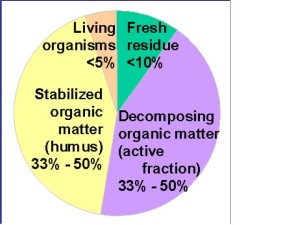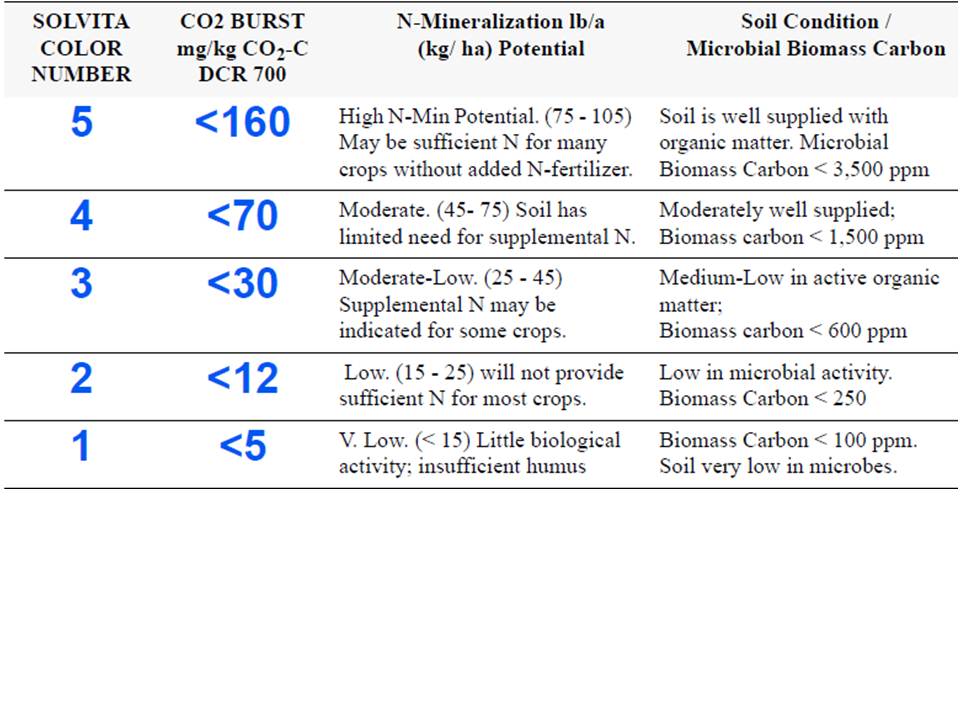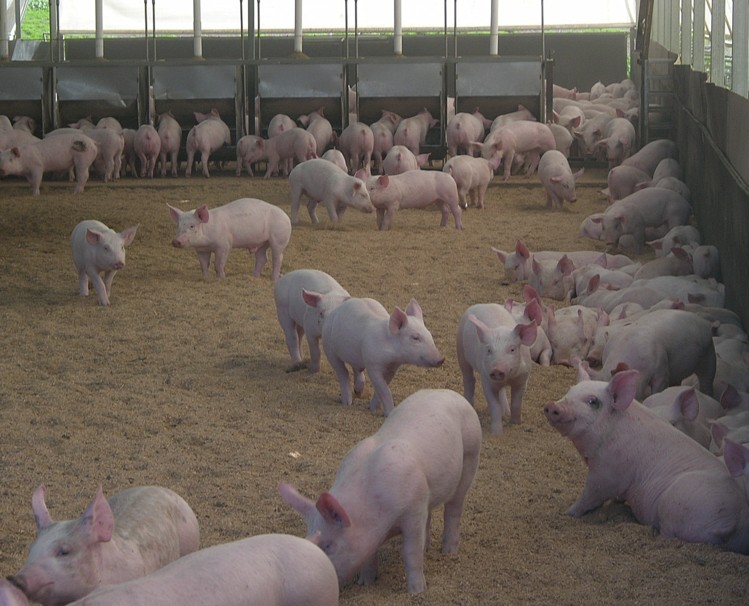Soil organic matter nutrient mineralisation
US data is demonstrating that soil organic matter mineralisation plus biomass respiration can contribute significant amounts of plant available nutrients for crops and pastures. This review by USDA soil scientist Mike Kucera, suggests high microbial biomass soils (particularly with high active fraction or labile organic matter) may not need any fertiliser nitrogen to achieve optimum crop yields. Requirements for fertiliser phosphorus are also reduced. Patrick Francis

Soil organic matter (SOM) is the organic component of soil, consisting of three primary parts including small (fresh) plant residues and small living soil organisms, decomposing (active) organic matter, and stable organic matter (humus).
Soil organic matter serves as a reservoir of nutrients for crops, provides soil aggregation, increases nutrient exchange, retains moisture, reduces compaction, reduces surface crusting, and increases water infiltration into soil. Components vary in proportion and have many intermediate stages, figure 1. Plant residues on the soil surface such as leaves, manure, or crop residue are not considered SOM and are usually removed from soil samples by sieving through a 2 mm wire mesh before analysis.

Soil organic matter content can be estimated in the field and tested in a lab to provide estimates for Nitrogen, Phosphorus and Sulfur mineralized and made available for crop/pasture production and to adjust fertilizer recommendations. Soil organic matter impacts the rate of surface applied herbicides along with soil pH necessary to effectively control weeds. Soil organic matter impacts the potential for herbicide carryover for future crops, and amount of lime necessary to raise pH.
Under average conditions in temperate regions (in USA) approximately 1.5 percent of SOM mineralizes yearly for most crops (2% spring planted row crops like corn, 1% small grains such as wheat, and 0.5% perennial grass pasture) while maintaining current organic matter levels on soils with 2 to 5% SOM . Depending on site conditions, management, and climate, mineralization rates and loss of SOM can increase dramatically if temperature, aeration, and moisture conditions are favorable.
Key soil functions SOM provide for include:
Nutrient Supply. Upon decomposition, nutrients are released through mineralisation in a plant-available form. While maintaining existing organic matter level, each one percent of SOM in the top 15 cm of a medium textured soil (silt and loam soils with a bulk density of 1.2) releases about 10 – 20 kg of nitrogen, 1 – 2 kg of phosphorus, and 0.4 – 0.8 kg of sulfur per hectare per year.
Another valuable source of nutrient availability beyond normal active organic matter mineralization is from the microbial organic matter pool that occurs when soil dries out and is re-wetted, a significant amount of N-flush can occur from this active fraction over the course of the growing period. This additional N-flush release is measured in the US with a soil CO2 respiration test (Solvita Soil Test). A typical example in a 2% SOM clay/loam soil with a bulk density of 1.2 g/cm3 has a mineralized organic N of 40 kg/ha/yr. An additional 20 – 30 kgN/ha/yr can be released from microorganisms due to soil wetting and drying.

There is no single explanation for the well known pulse of carbon dioxide or “CO2-Burst” that results as soil re-activates from moisture, but it is associated with a positive nutrient flux. Therefore this application of the Solvita Soil Test represents potential soil N mineralization. Table 1 shows that in high microbial biomass carbon soil the potential N mineralisation is 75 – 105 kg/ha over the crop growing season in a humid-temperate environment which may be sufficient N for many crops to grow without added fertiliser. In contrast in soils with low microbial biomass N mineralisation is very low and will not support crop growth.
High soil respiration rates are indicative of high biological activity (refer to Tables 1 and 2). This can be a good sign of a healthy soil that readily breaks down organic residues and cycles nutrients needed for crop growth. Solvita® response may go from an inactive condition (0-1) to a very active state (3.5-4.0) as soil respiration increases from desirable management measures such as diverse crop rotations, and no-till.
In some cases, heavily manured soils or soils high in organic content can attain a very high rate (5). This can be detrimental when decomposition of stable organic matter occurs. It is generally desirable to have at least 3. It typically takes several years for a soil to improve from a low biological status to a more active one. With proper residue management, diverse crop rotations, organic matter additions and avoidance of destructive tillage practices, the time to reach a more optimum condition is shortened.

Water-Holding Capacity. Organic matter behaves somewhat like a sponge. It has the ability to absorb and hold up to 90 percent of its weight in water. Another great advantage of organic matter is that it releases nearly all of the water it holds for use by plants. In contrast, clay holds great quantities of water, but much of it is unavailable to plants.
Soil Aggregation. Organic matter improves soil aggregation, which improves soil structure. With better soil structure, water infiltration through the soil improves, which improves soil’s ability to take up and hold water.
Erosion Prevention. Because of increased water infiltration and stable soil aggregates erosion is reduced with increased organic matter.
Estimating organic material needed to increase SOM
The term steady state is where the rate of organic matter addition from crop/pasture residues, roots and manure or other organic materials equals the rate of decomposition. If the rate of organic matter addition is less than the rate of decomposition, SOM will decline and, conversely if the rate of organic matter addition is greater than the rate of decomposition, SOM will increase.
A hectare of soil 20 cm deep weighs approximately 4.8 million kgs, which means that 1 percent SOM weighs about 48,000 kgs per ha. Under average conditions it takes at least 4.2 kg of organic material to decompose into 0.4 kg of organic matter, so it takes at least 91,000 ks (90 tonnes) of organic material applied or returned to the soil to add 1 percent humus or stable organic matter under favorable conditions .
Pasture versus plantation soil organic matter
Soils formed under grass (prairie) vegetation usually have organic matter levels at least twice as high as those formed under forests because organic material is added to topsoil from both top growth and roots that die back every year. Soils formed under forests usually have comparably low organic-matter levels for two main reasons:
1. Trees produce a much smaller root mass per acre than grass plants, and
2. Trees do not die back annually and decompose every year. Instead, much of the organic material in a forest is tied up in the tree’s wood rather than being returned to the soil annually.
Soil organic matter generally increases where biomass production is higher and where organic material additions occur. Plant residue with a low C/N ratio (high nitrogen content) decompose more quickly than those with a high C/N ratio and do not increase soil organic matter levels as quickly. Excessive tillage destroys soil aggregates increasing the rate of soil organic matter decomposition. Stable soil aggregates increase active organic matter and protect stable organic matter from rapid microbial decomposition. Measures that increase soil moisture, soil temperature, and optimal aeration accelerate SOM decomposition.
Management measures in a field can either degrade or increase SOM. Some key management measures that can increase SOM are shown below.
- Use of cropping systems that incorporate continuous no-till, cover crops, solid manure or other organic materials, diverse rotations with high residue crops and perennial legumes or grass used in rotation.
- Reducing or eliminating tillage that causes a flush of microbial action that speeds up organic matter decomposition and increases erosion.
- Reduce erosion using appropriate measures. Most SOM is in the topsoil. When soil erodes, organic matter goes with it. Saving soil and SOM go hand in hand.
- Soil-test and fertilize properly. Proper fertilization encourages growth of plants, which increases root and top growth. Increased root growth can help build or maintain SOM, even if you are removing much of the top growth.
- Use of perennial forages provides for annual die back and re-growth of perennial grasses and their extensive root systems and aftermath contributing organic matter to soil. Fibrous root systems of perennial grasses are particularly effective as a binding agent in soil aggregation.
Source: Taken from USDA NRCS Soil Organic Matter Guide for Educators, written by Mike Kucera, Agronomist—National Soil Survey Center.



